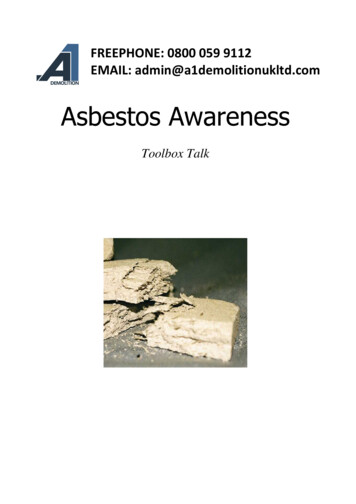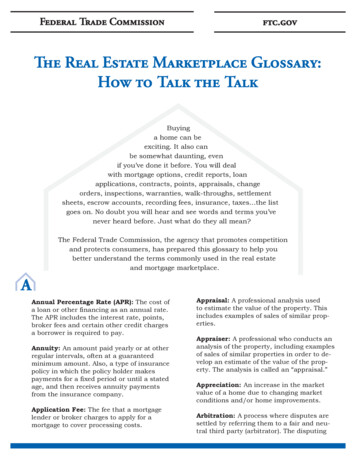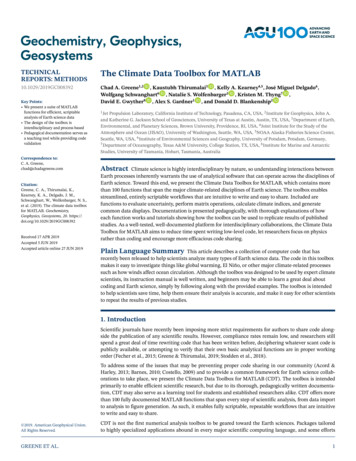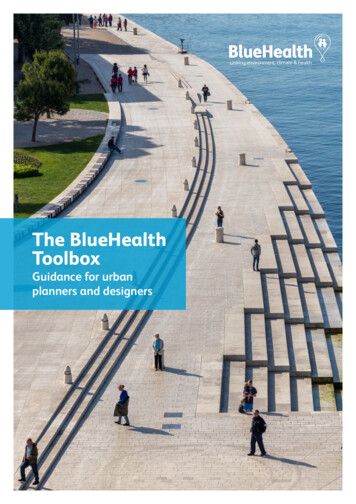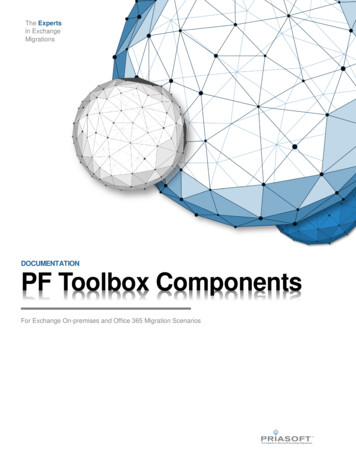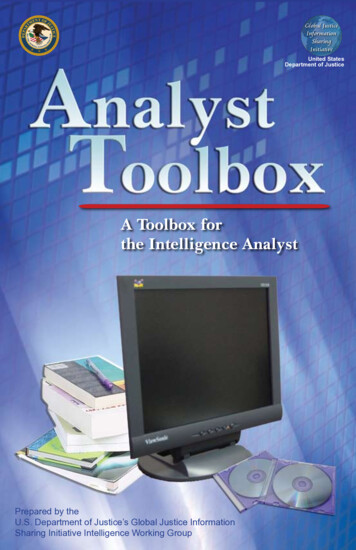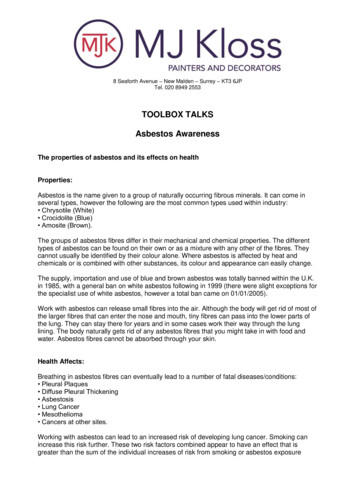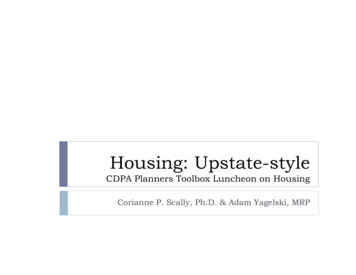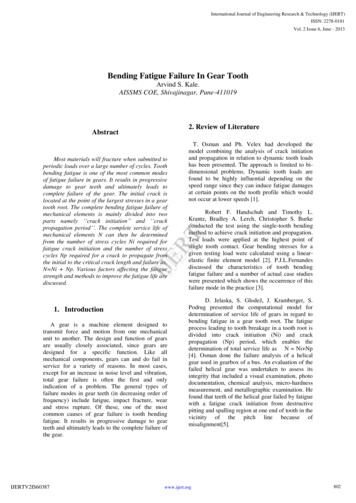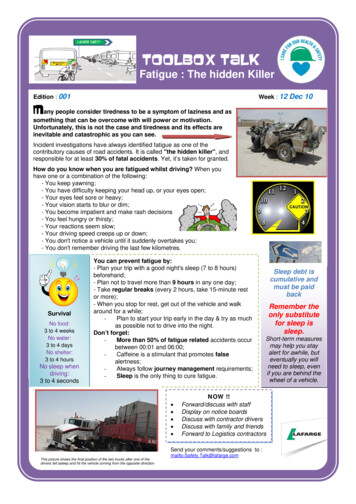
Transcription
Toolbox TalkFatigue : The hidden KillerEdition : 001Week : 12 Dec 10Many people consider tiredness to be a symptom of laziness and assomething that can be overcome with will power or motivation.Unfortunately, this is not the case and tiredness and its effects areinevitable and catastrophic as you can see.Incident investigations have always identified fatigue as one of thecontributory causes of road accidents. It is called "the hidden killer", andresponsible for at least 30% of fatal accidents. Yet, it’s taken for granted.How do you know when you are fatigued whilst driving? When youhave one or a combination of the following:- You keep yawning;- You have difficulty keeping your head up, or your eyes open;- Your eyes feel sore or heavy;- Your vision starts to blur or dim;- You become impatient and make rash decisions;- You feel hungry or thirsty;- Your reactions seem slow;- Your driving speed creeps up or down;- You don't notice a vehicle until it suddenly overtakes you;- You don't remember driving the last few kilometres.SurvivalNo food:3 to 4 weeksNo water:3 to 4 daysNo shelter:3 to 4 hoursNo sleep whendriving:3 to 4 secondsYou can prevent fatigue by:- Plan your trip with a good night's sleep (7 to 8 hours)beforehand;- Plan not to travel more than 9 hours in any one day;- Take regular breaks (every 2 hours, take 15-minute restor more);- When you stop for rest, get out of the vehicle and walkaround for a while;Plan to start your trip early in the day & try as muchas possible not to drive into the night.Don’t forget:More than 50% of fatigue related accidents occurbetween 00:01 and 06:00;Caffeine is a stimulant that promotes falsealertness;Always follow journey management requirements;Sleep is the only thing to cure fatigue. Remember theonly substitutefor sleep issleep.Short-term measuresmay help you stayalert for awhile, buteventually you willneed to sleep, evenif you are behind thewheel of a vehicle.NOW !!Forward/discuss with staffDisplay on notice boardsDiscuss with contractor driversDiscuss with family and friendsForward to Logistics contractorsSend your comments/suggestions to :This picture shows the final position of the two trucks after one of thedrivers fell asleep and hit the vehicle coming from the opposite directionSleep debt iscumulative andmust be paidbackmailto:Safety.Talk@lafarge.com
Toolbox TalkThreats at ParkingEdition: 010Threats at ParkingWeek: 13 Feb 11Accidents at parking lots are common these days; they are either caused bycareless driving, pedestrians or combination of both. A driver’s assistant slept undera vehicle at a parking lot and got crashed by that vehicle’s driver as he was movingout.All drivers Park and move in and out of parking or Rest areas daily. A lot ofthings can go wrong between the time you steer your vehicle into theparking lot and the time you move out. Traffic accidents, falls and assaultsare just a few of the threats of workplace parking lots and garages.Serious injury and fatality can occur at these low speed maneuvers.In most countries with very hot climates, people often look for a shade andcool area to rest. Parked Heavy Goods vehicles seem to provide thisenvironment and third party fellow workers rest under these vehicles withoutrealizing that they are committing an unsafe act.It is important to follow safe and proper techniques to prevent driving overpersons that could be resting under the vehicle.What must a Driver do before starting his vehicle and Driving off?Make it a habit to GET OUT AND LOOK even if the stop was for just a fewminutes. Before manoeuvring your vehicle - get out and look around thevehicle; under the vehicle and the immediate surrounding that you aremanoeuvring out from. Walk around your vehicle, especially to the rear, toget a complete picture. Proceed immediately before the picture changes.Make certain that mirrors are clean and properly adjusted.Too often, driversforget to properly adjust and clean mirrors to gain maximum visibility.Some tips:Slow down when driving through a parking lot. Excessivespeed is the cause of many accidents in these congestedareas.Be alert to inattentive pedestrians, vehicles backing outof parking spacesThe combinationof vehicles andpedestrians in anarea poorlycontrolled bytraffic signsmakes the typicalparking lotperilous. Stay alertas a driver and asa pedestrian.Pay attention to where you are parking. Can you find thevehicle promptly upon your return? Will this be a safeplace to walk when you get off work after dark?When you are walking, never assume a driver sees you.Don’t get so wrapped up in conversation with a friendthat you step out in front of a vehicle.Stick to the pedestrian walkways and agreed circulationplan at the site.Wear sturdy shoes with low heels and non-slip shoes foryour commute; change your shoes when you get to work,if needed. NOW !!Forward/discuss with staffDisplay on notice boardsDiscuss with contractor driversDiscuss with family and friendsForward to Logistics contractorsRemember:Poor lightingon both thevehicle and theparking area,isolated areasand roughwalkingsurfaces add tothe dangers.
Toolbox TalkHeadrest for whiplash injuryEdition: 011Headrest for whiplash injuryWeek: 20 Feb 11When you enter your vehicle, do you think to check if your headrest is properlyadjusted? Did you know that a poorly adjusted headrest can cause seriousinjuries in an accident?Every year, thousands of drivers suffer whiplash injuries after a roadaccident. Most cars and trucks are equipped with headrests, but mostdrivers don’t know how useful these are, some even think headrests arejust there for comfort. They have a much more important purpose.What is Whiplash Injury?Whiplash is an acute injury of at least moderate intensity which causes astrain to the bones, muscles, nerves, tendons, and vertebral discs of theneck region. It is caused by a sudden, unexpected impact which jerksthe head back and then forward causing the neck to snap out ofalignment.How Does Whiplash Occur?Whiplash occurs mainly as a result of a vehicle being struck in the rear orside by another vehicle. The impact causes a transfer of energy that mayinjure bones or soft tissue (whiplash), which may in turn lead to ailmentssuch as neck pain and stiffness, dizziness, and headaches.What are the Symptoms?Headaches/migraines neck pain, dizziness (nausea/vomiting), problemsthinking or remembering, numbness and tingling (arms, face, shoulders),low back pain, hip pain, impaired vision Illustrations from http://www.rospa.co.uk/roadsafety/info/adjust head restraints.pdfThe main purpose of the headrest is to guard against whiplash injury.Some tips to prevent/minimize whiplash injury:For a headrest to be efficient, it should:be made of the same material as the seat;be sufficiently strong to hold up under impact;A poorly adjustedheadrest servesno purpose!If the headrest istoo low, thedriver's head willbe thrown backviolently in a rearcollision. Whiplashmay occur as aresult.be sufficiently soft to avoid the occupant's head frombouncing forwardnot be more than 10 centimeters from the back of thehead. The middle of the headrest should be level withthe eyes or the top of the earsbe tilted forward. The closer the headrest is to theback of your head, the safer you'll be.Also, remember to check or adjust the headrest each timeyou get into your car, especially if another person hasrecently been driving it. NOW !!Forward/discuss with staffDisplay on notice boardsDiscuss with contractor driversDiscuss with family and friendsForward to Logistics contractorsEven low speedaccidents cancause significantinjuriesdepending onwhere and howhard your car gothit, your positionin the car, theposition of yourhead, type ofseat, position ofthe headrest
Toolbox TalkKill your speed .Edition: 002Kill your speed before it kills you!!!Week: 19 Dec 10Some excuses people often give after accident!!!“ suddenly the vehicle in front stopped.Everyone else was speeding.I slammed the brakes on but I couldn’t stop in time.Suddenly a car pulled out from nowhere. . “Speed is one of the main causes of many road accidents.Not everybody understands or realises how fast is “fast”: At 60 kph one travels 17 meters per second;At 80 kph, 22 meters per second.At 100 kph, 28 meters per second.It is really important to know that the braking distanceincreases dramatically as the speed increases. At threedifferent speeds, the shortest possible stoppingdistances under PERFECT conditions (a dry road,excellent brakes, and an alert driver) are:NB: Alcohol, drugs, fatigue, food, illness can affect yourReaction Time thus increasing your stopping distance.SpeedStopping distance40 kph60 kph80 kph28 m58 m100 mIn order to be prepared for the “unexpected” and reactto it, a driver has to:ABS does notreduce brakingdistance!! It allowsyou to maintainsteering duringheavy braking byreleasing individualwheels prior tolocking up andreapplying them. Always keep within speed limit; Adjust speed to road, traffic and weatherconditions; Maintain a reasonable forward and rear "buffer" ofspace around your vehicle. Safety distance shouldnot be less than 2 seconds in a light vehicle and4 SECONDS for logistics vehicle;(Always add a further second each for: wet roads,poor visibility, and night.) Concentrate on the driving task; Anticipate what hazards could be present in partsof the road that are not visible. No appointmentor job is sourgent thatspeeding can bejustified!!!NOW !!Forward/discuss with staffDisplay on notice boardsDiscuss with contractor driversDiscuss with family and friendsForward to Logistics contractorsSend your comments/suggestions to :mailto:Safety.Talk@lafarge.comThis picture shows what’s left after a speed related accident. The wholefamily ( driver and passengers) were killed in the accidentA little more speedcan result in awhole lot moredistance that isrequired to stop.This is often farmore in metersthan people realize.
Toolbox TalkDeadly distractionsDeadly distractionsEdition: 003Week: 26 Dec 10What is a distraction?It’s anything that takes your hands, eyes or attention away fromdriving. Among the most common driving distractions are: Adjusting the radio, cassette or CD player Using/dialing a wireless phone Eating and drinking while driving Smoking while driving Engaging in any discussion with passengers which can lead tonon focus on the road and hazards Outside distractions, including: Accidents, Vehicles stopped bypolice, Friends in other vehicles, Roadside advertising, Newconstruction (shops, restaurants, etc.)Mobile Phones distractionsWhen you’re searching for a number, dialing or talking, you’re notwatching the road like you should. When using a hand held mobilephone you will travel an additional 14 metres before you will cometo a stop in an emergency braking situation.Remember: The use of cell-phones, hand-free devices whenA simple second of distraction took awayher life and dreamsoperating a vehicle is prohibited by LafargeTurning Knobs Means Turning Your HeadThink about it; let’s say you’re going 80 km/h. If you lookdown for just two seconds to choose a CD or adjust theA/C controls, you’ll have travelled 44 meters blindly.Several studies havedemonstrated thattalking on a mobilephone distracts adriver, even with ahands-free device.Texting and using“smart phones” thatprovide e-mail access make it worse.Inserting a CD or searching for a radio station makesyou six times more likely to get into an accident thanglancing at the fuel gauge or speedometer.Try these tips to help keep your attention on the road: Ask your passenger to adjust the radio controlsor change your CD for you.Take advantage of normal rest stops to adjustcontrols or do other things.With more complex devices – GPS/navigationsystems, etc. – take the time to stop in a safeplace before giving them your attention. NOW !!Forward/discuss with staffDisplay on notice boardsDiscuss with contractor driversDiscuss with family and friendsForward to Logistics contractorsSend your comments/suggestions to :mailto:Safety.Talk@lafarge.comYou might nothave a secondchance and,Don’t thinkthis can’thappen toyou.
Toolbox TalkNight drivingNight drivingEdition: 004Week: 02 Jan 11Night driving is defined as driving in hours of full darkness,from 15 minutes after sunset until 15 minutes before sunrisewhen daylight is not enough for good visibility.In most countries, statistics have shown that the risk of accidentsincreases at night. Other vehicles and road users may not be easilyvisible and often seem to suddenly appear. Drivers and pedestriansmay be intoxicated by use of drug and alcohol or affected by fatigue,making their behaviour more unpredictable and dangerous.An unlit road presents dangerous situations such as pedestrianswalking on the road wearing dark clothes, cyclists and vehicles withfaulty or no rear lights.During daylight animals react to an approaching vehicle by runningaway but at night they tend to freeze when faced by the headlights ofa vehicle.It is difficult to judge the distance of an approaching vehicle or one infront of you and this must be taken into consideration whenovertaking or approaching a vehicle.Bright lights of oncoming vehicles are another hazard. Never react tothis by switching on your own vehicle’s bright lights.Fatigue is also one of the main hazards of night driving that canaffect either yourself or other drivers. Don’t try to beat fatigue.This fatal accident happened last year at10.20 pm in a BU delivery operationsSome tipsThere is anincreased risk offalling asleep duringthe night with thepotential forcollision androllover-Plan your trip beforehand. The best option is to avoiddriving at night. Check if night driving is permitted inyour BU.-Don’t get behind the wheel if you feel tired and if youstart to feel sleepy, you should find a safe place to stop(not the hard shoulder of a motorway) as soon aspossible.--Speed should be reduced at night as vision is restrictedand your stopping distance should be within the area ofthe light of your headlamps.Be alert for vehicles that may have broken down andare parked on the side of the road.Delivery vehicles should be fitted with reflective tape toincrease their visibility. This vehicle rolled over after a collision with an animal in the night. Twopeople died and one injured.NOW !!Forward/discuss with staffDisplay on notice boardsDiscuss with contractor driversDiscuss with family and friendsForward to Logistics contractorsSend your comments/suggestions to :mailto:Safety.Talk@lafarge.comRemember:Night driving onLafarge businessneeds approvalof BU GM subjectto documentedand approvedRisk assessment
Toolbox TalkWet-weather DrivingWet-weather drivingEdition: 005Week: 09 Jan 11Most people tend to blame the weather for related accidents but thisis just an excuse. Rain and wet roads are the most common hazardsthat we face in our driving experiences.Failure to respond to the hazards and risks associated with poorweather conditions is the main cause of accidents linked to driving inthe rainWeather conditions affect traction, visibility and vehicle control.Our vehicles need more space and distance to be controlled, so weneed to make additional allowances of at least twice what we wouldallow in dry weather to cope with wet conditions.The tires need to be in good condition as the tyre contact on the roadis important. Unless there is sufficient tread depth, the tires can’tpump or push water away from out tracks.Using worn out tires or tires with insufficient tread means that ourvehicle will be more likely to hydroplane and skid.Hydroplaning is when tires loose grip because of build up of waterbetween the tyre and the road.Hydroplaning (Aquaplaning) caused byTread FailuresSome tips Check your windscreen wipers well in advance, Check and make sure tires are in good condition withtread depth of no less than 2 mm that covers the entirebreadth and round it’s entire circumferencePoor weatherconditions havenever caused anaccident.Drivers who fail torespondappropriately toweather conditionscause accidents. Warm up your windscreen to improve visibility inaddition to the use of wipers Keep a safe speed and your lights on whilst driving Wet-weather driving demands gentle use of––––– SteeringClutchBrakeAcceleratorLarger allowance for errors and emergenciesStop in a safe place during heavy rain if the visibilityis poor and you are not familiar with the road NOW !!Forward/discuss with staffDisplay on notice boardsDiscuss with contractor driversDiscuss with family and friendsForward to Logistics contractorsSend your comments/suggestions to:mailto:Safety.Talk@lafarge.comA vehicle thatis lightly ladenis more pronetohydroplaningbecausethere is lessweight /pressure onthe tires
Toolbox TalkHead-On CollisionsEdition: 006Head-On collisionsWeek: 16 Jan 11You’re driving down a two-lane road and you see a car approaching inyour lane at a high speed. You blow your horn, but the car continuesto move toward you in your lane. You think the driver might be asleepor drunk or he is just a non experienced driver etc. You are aboutgetting involved in a head-on collision.Head –on collisions are defined as those accidents in which vehiclescollide in the same lane. Most of these events happen when the“Wrong Way Driver” is drunk, drugged out or totally incapacitated fromsome other cause.In most cases, more than 50% of people in the two cars die whileothers get seriously injured. Unrestrained occupants are thrownforward where they hit the car interior, vehicles rotate about oneanother very rapidly, and this spinning action tends to hurl passengersto the rear of the car and to the side of the vehicle that has beendamaged. The speed at which vehicles approach each other isgenerally too fast to permit driver actions that reduce impact severity.This accident happened last week where acompetitor’s aggregate truck collided with abus killing 11 people and injured 5 othersIt’s important to remain alert! Don’t fall asleep at the wheel, don’t drivewhile impaired by alcohol & drug, don’t cross the centre line, don’ttake your eyes off the road, keep at or below the speed limit.in short:concentrate on driving!Some tips to avoid head-on collisionsRemember the 5 Rs1. Read the road ahead. See forward, make useyour horn and lights to “wake other driver up”.Make sure all passengers use their seat beltA direct “head-on” is a“dead” stop. Nochance!In a collision, theoccupants of thelighter car wouldexperience muchhigher accelerations,hence much higherforces than theoccupants of theheavier car2. Reserve a space on the side of your vehicle forsafe manoeuvring to the right3. Drive to the Right; If you move to the left, thehead-on collision you were hoping to avoid maystill happen. If the oncoming driver recovers, hemay instinctively swerve back into his proper lane.NEVER DRIVE TO THE LEFT4. Reduce speed and wait as long as you can to pullout of your lane5. Ride off the road to the right if necessary. Pull asfar to the right as possible NOW !!Forward/discuss with staffDisplay on notice boardsDiscuss with contractor driversDiscuss with family and friendsForward to Logistics contractorsSend your comments/suggestions to:mailto:Safety.Talk@lafarge.comDriving off theroad isn’twithout risk:There is apossibility ofgetting injuredwhich is alwaysbetter than ahead-oncollision. Aimfor somethingrelatively soft
Toolbox TalkStuck AcceleratorEdition: 007Stuck acceleratorWeek: 23 Jan 11Finding yourself in a car with a stuck accelerator pedal is a terrifyingexperience for any driver; below are comments from a victim:. ”My car started to accelerate. “I was in tears – I really could see myselfdying, I took my foot off the accelerator – but I wasn’t slowing down at all. I hitthe brakes. They were braking ok, they were keeping me at about 70mph Then the brakes started burning out – I could see smoke coming from thebrakes ” He had to drive on the hard shoulder to avoid crashing but lostcontrol and hit a ro
Toolbox Talk Fatigue : The hidden Killer. Edition: 001 Week: 12 Dec 10. This picture shows the final position of the
